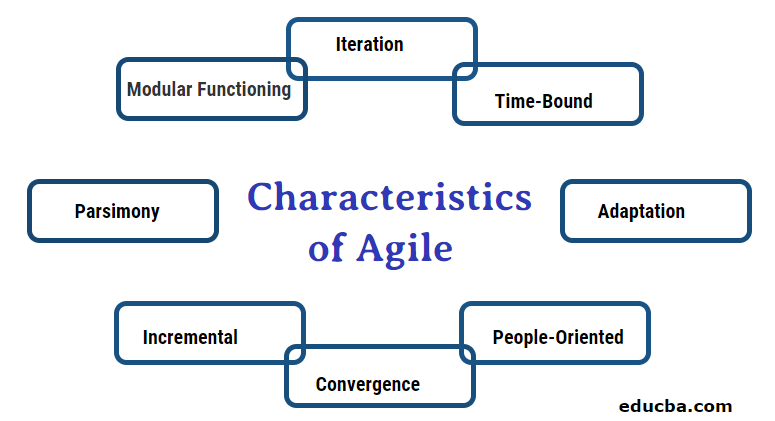
Introduction to Agile Characteristics
The software development life cycle is known for trying different approaches based on requirements for project development. Software development mainly considerate two points that are an emphasis on process and the quality of the software and process itself. Agile process is one of the software development method for good results, agile is iterative in nature and development is incremental based. The agile development method follows is an adaptive approach and works better when the customer requirements are changeable at any stage before development. Agile approach prioritizes the customer over the process, it welcomes the changes by the customer at the later stage also, the team is adaptive and makes changes accordingly. The customer is included throughout the process and every stage completion is shared with the customer for further reviews, this way agile development process is considered one of the best methodologies.
Characteristics of the Agile Development Method
Characteristics of Agile Development Method are as follows:
Agile development method works by dividing the task into small sub-tasks termed as increments and builds the project’s ultimate deliverables in small increments by repeating basic steps over and over. It requires less planning during the development process, it mainly works for short term projects, the team efforts make a project successful. The agile development process is lightweight and provides incremental and continuous delivery. Agile development teams are working on a full-time basis and persist project to project.
1. Modular Functioning
Modularity is considered one of the key elements of a good process. Modularity is the element that allows the components to break down and that broken component is called activities. The software development process is just the set of activities that frames or transforms the vision of the software system into reality. Agile Software development process makes use of good tools and is wielded with good software craftsman who is well known to apply those at the right place and right time. These can not be utilized for the production line for manufacturing software products.
2. Iteration
The agile software development process acknowledges the working on attempting wrong before its correct. So, for this reason, agile processes focus on small cycles. Each cycle has a task of defined activities and those activities must be completed in a correct manner, these cycles have a time slot of a week, from starting to completing the activities. The iteration i.e single cycle may or may not get a 100 % correct element. Because of this reason one short cycle is repeated several times until the correct result is achieved.
3. Time-Bound
Software development comes with time limits or the development team must give a delivery date to the customer, to keep things under track the iterations play a good role as it keeps time limit between one and six weeks on each iteration and it can be scheduled accordingly. There are higher chances that it may not schedule all activities in a single iteration, else wise only those activities will be attempted which are necessary to achieve the goals which were set at the beginning of the iteration. Rescheduling or functionality reduction can be done to deliver the project on time, on the allotted time.
4. Parsimony
Agile software development is considered an upgraded version of the traditional approach with time constrains add on. Impossible deadlines are not attempted for rapid delivery, each phase of development is kept in mind as this attempt may take away the quality from the product and that’s a big NO. Instead, agile approach focus on parsimony keeps the activities to minimal and only necessary to mitigate risks and achieve their goal.
5. Adaptation
During the development or during iterations there are higher chances of unknown risks they may be exposed; the agile approach is prepared to deal with these unknown risks. If there are changes in different results during the functionality, new activities or functionality can be added to reach the goal.
6. Incremental
Agile system is not built entirely at once, the system is partitioned and look out for increments that can be parallelly developed, at a different time and a different rate. Each increment is tested independently and if found ok then all are integrated into the one system for the result.
7. Convergence
It means that the risks are attacked actively because it is worth to know the risks. This takes the system closer to the results. Risks solving during each iteration is one of the great processes that leads to a successful iteration.
8. People-Oriented
The agile process is known for its priority towards customers over process and technology. The involvement of the customer is done organically. The developers evolve through adaptation and are empowered to raise their productivity and performance. These developers are very aware of dealing with the changes in the system at every stage.
9. Collaboration
The agile process has a very practical approach for discussions that is face-to-face discussion whether it is with the customer or with the team members itself. Good communications play an important role in the success of the project in the software development field. The risk of miscommunication is higher when the system is developed into pieces, it is a must for every member to understand how pieces fit together for creating a final product. The process is more into integration than to communication when individual iterations are completed. Integrating the smaller integrations into larger part developed parallelly requires collaboration with the teams to fix it correctly into the system to get the final product.
Conclusion
Agile processes are the evolution of best practices used over the years for software development. there is no rocket science to deliver a successful project, it requires hard work and good knowledge for the pitfalls. One should understand choosing the process because every process does not work for all the projects, the false process can lead to an unsuccessful project. The team should have some experienced mates who have practiced several development processes, this can be beneficial in identifying the process to choose for the required project.
Recommended Articles
This is a guide to Agile Characteristics. Here we discuss the Introduction of Agile Characteristics along with Characteristics of the Agile Development Method Which Includes Modular Functioning, Iteration, Time-Bound and Parsimony, Adaptation. You may also look at the following articles to learn more –


